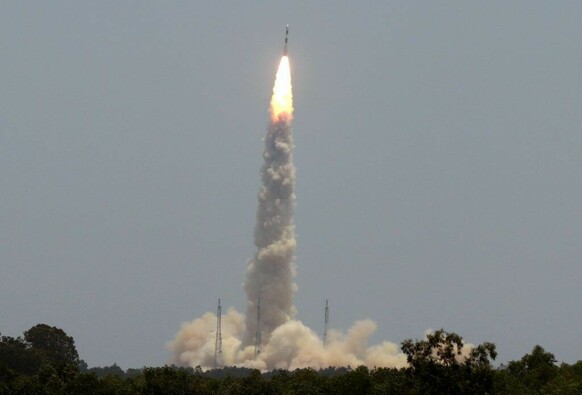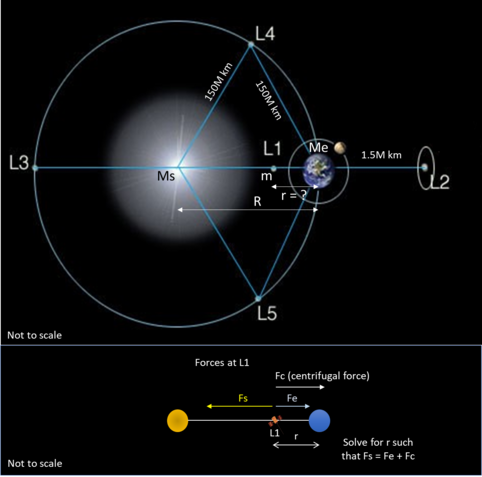News18 India · @News18India
31 followers · 734 posts · Server india.goonj.xyzAditya-L1 is the first Indian space-based observatory that will study the Sun from a halo orbit around the first Sun-Earth Lagrangian point (L1), which is located roughly 1.5 million km from the Earth
#AdityaL1 #ISRO #Mission #StudySun #SuccessfullyUndergoesThirdEarth
https://www.news18.com/india/aditya-l1-mission-sun-isro-spacecraft-successful-third-earth-bound-manoeuvre-8571364.html
#adityal1 #isro #mission #studysun #successfullyundergoesthirdearth
MagnetoMancer · @magnetomancer
4 followers · 21 posts · Server mastodon.nlNow we see Ocean between us, and Space between worlds.
#Space #ISRO #AdityaL1
https://www.kooapp.com/koo/BN_Adhikari/704eb037-8892-47e2-80c2-37f12745b559
Hindustan Times · @HindustanTimes
45 followers · 1062 posts · Server india.goonj.xyzISRO's Aditya L1 solar mission successfully completes third earth-bound manoeuvre on its journey to the Sun.
#AdityaL1 #India #ISRO
https://www.hindustantimes.com/technology/aditya-l1-indias-first-solar-mission-completes-3rd-earth-bound-manoeuvre-says-isro-101694295068676.html
The Times Of India · @timesofindia
74 followers · 749 posts · Server india.goonj.xyzStating that Sunday's manoeuvre happened at 2.30am, Isro said: "Ground stations at Mauritius, Bengaluru, SDSC-SHAR (Sriharikota) and Port Blair tracked the satellite during this operation." The spacecraft is now in an orbit of 296km x 71,767km and the next Earth-bound manoeuvre is scheduled for 2am on September 15. Aditya-L1 is a satellite dedicated to the comprehensive study of the Sun.
#AdityaL1 #India
https://timesofindia.indiatimes.com/india/aditya-l1-completes-3rd-earth-bound-manoeuvre/articleshow/103541554.cms
Raymond Scott Pert · @raymondpert
1718 followers · 706 posts · Server mstdn.social> #India’s Aditya-L1 spacecraft recently took some remarkable pictures of Earth and the #Moon from #space while it was on its way to a special place called Lagrange Point 1. In addition to these pictures, the spacecraft even shared a selfie.
> Right now, it’s making its way to a spot known as the Sun-Earth L1 point. This location in space is quite unique because it’s where the gravitational forces of the Sun and Earth balance out perfectly.
https://www.firstpost.com/tech/news-analysis/watch-aditya-l1-shares-an-epic-selfie-with-the-earth-moon-from-its-journey-to-the-sun-13090232.html #AdityaL1 #isroindia #isro
#isro #isroindia #adityal1 #Space #moon #India
Ganga News · @ganganews
7 followers · 448 posts · Server flipboard.socialISRO continues to make significant strides in its Aditya-L1 solar mission, which aims to study the Sun’s outer atmosphere and space weather.
#ISRO #AdityaL1 #SolarMission #SpaceWeather #OrbitManeuver #SpaceExploration #Sun
https://www.ganganews.com/science/aditya-l1-isro-successfully-performs-second-orbit-maneuver/
#isro #adityal1 #solarmission #spaceweather #orbitmaneuver #spaceexploration #sun
Hindustan Times · @HindustanTimes
46 followers · 1058 posts · Server india.goonj.xyzAditya L1 mission latest updates: India's space-based Sun observatory completes second orbital adjustment, preparing for journey to Lagrange 1 Point.
#AdityaL1 #Earth
https://www.hindustantimes.com/india-news/isro-elevates-aditya-l1-to-earth-orbit-40-000-km-away-what-does-it-mean-101693882386269.html
Hari Tulsidas :verified: · @haritulsidas
327 followers · 1663 posts · Server masto.aiIndia has launched a spacecraft to study the Sun, becoming the first Asian country to do so. The spacecraft, named Aditya-L1, will orbit around a point between the Earth and the Sun, where the gravitational forces are balanced. The mission aims to understand the Sun’s dynamics, such as its magnetic field, solar flares, and coronal mass ejections, which can affect the Earth’s climate and communication systems. #AdityaL1 #SunMission #IndiaSpace
#adityal1 #sunmission #indiaspace
Fɹancisco J Яodríguez Amorín · @rodriguezamorin
752 followers · 4655 posts · Server masto.nobigtech.esDurante su misión a la Luna, la India mandará otra para estudiar el Sol.
Este sábado está previsto el lanzamiento del observatorio solar #AdityaL1 para investigar cuestiones abiertas sobre nuestra estrella, según ha anunciado la Organización de Investigación Espacial de la India (#ISRO).
#AgenciaSINC
#ciencia
#Astronomía
#Astrofísica
https://www.agenciasinc.es/Noticias/Durante-su-mision-a-la-Luna-la-India-mandara-otra-para-estudiar-el-Sol
Más #podcast
https://rodriguezamorin.blogspot.com/p/radios.html?#Ciencia
#adityal1 #isro #AgenciaSINC #ciencia #astronomia #Astrofisica #podcast
scinexx - das wissensmagazin · @scinexx
653 followers · 695 posts · Server nrw.socialIndien: Erst der Mond, jetzt die Sonne. Indisches Sonnenobservatorium Aditya-L1 erfolgreich gestartet. #Indien #ISRO #AdityaL1 #Sonnensonde #Raumsonde #Sonnenobservatorium
https://www.scinexx.de/news/kosmos/indien-erst-der-mond-jetzt-die-sonne/
#Indien #ISRO #adityal1 #Sonnensonde #Raumsonde #Sonnenobservatorium
Ganga News · @ganganews
6 followers · 413 posts · Server flipboard.socialIndia’s successful launch of its first Solar mission, Aditya-L1, has garnered support from ESA which will play a crucial role in assisting the ISRO.
#ISRO #India #ESA #SolarMission #AdityaL1 #IndiaNews
https://www.ganganews.com/tech/european-space-agency-assist-isro-in-aditya-l1-solar-mission/
#isro #india #esa #solarmission #adityal1 #indianews
AkaSci 🛰️ · @AkaSci
1942 followers · 1893 posts · Server fosstodon.orgThe other name we see mentioned often is Aditya-L1 project director Nigar Shaji, who headed the project team at ISRO.
AkaSci 🛰️ · @AkaSci
1939 followers · 1890 posts · Server fosstodon.orgThe Lagrange points are named after pioneering mathematician, physicist and astronomer Joseph-Louis Lagrange (Jan 25, 1736 – Apr 10, 1813).
Lagrange made significant contributions to the fields of analysis, number theory, and classical and celestial mechanics.
His study of the 3-body problem and Lagrange points is described in this famous 1772 paper “Essai sur le Problème des Trois Corps.”
https://en.wikipedia.org/wiki/Joseph-Louis_Lagrange
https://cosweb1.fau.edu/~jmirelesjames/StromgrenTranslation.pdf
#AdityaL1#Lagrange
8/n
AkaSci 🛰️ · @AkaSci
1936 followers · 1888 posts · Server fosstodon.orgObjects cannot be placed exactly at L1 as they will drift off after any minor deviations. Hence, they are stationed in orbits around the L1 point, which are more stable, but still require periodic (monthly) small adjustments.
The math to compute the parameters for Halo/Lissajous orbits is much more complex.
#AdityaL1
7/n
AkaSci 🛰️ · @AkaSci
1936 followers · 1888 posts · Server fosstodon.orgHence, we get
G * Ms * m / (R - r)^2 = G * Me * m / r^2 + m * w^2 * (R - r)
Removing m, we get –
G * Ms / (R - r)^2 = G * Me / r^2 + w^2 * (R - r)
One can solve for r iteratively using a spreadsheet or a simple computer program.
Plugging in –
G = 6.674E-20 km^3 / kg / s^2
Ms = 1.989E+30 kg
Me = 5.9722E+24 kg
R = 149,597,870 km
w = 2 * pi / (365.25 * 24 * 3600) radians/sec (that of earth)
We get r = 1,487,940 km, which is close to the 1,500,000 km value commonly referenced.
#AdityaL1
6/n
AkaSci 🛰️ · @AkaSci
1936 followers · 1886 posts · Server fosstodon.orgHere is a simple approx. method to compute the distance between L1 and Earth.
Let’s assume circular orbits.
At L1, the centrifugal force due the object's orbital motion must balance out the gravitational forces of Earth and the Sun.
i.e., Fsun = Fearth + Fc
Using the notations from the diagram, we have
Fsun = G * Ms * m / (R - r)^2 (Newton’s equation, G is the Gravitational constant)
Fearth = G * Me * m / r^2
Fc = m * w^2 * (R - r) (w (omega) is the angular speed in radians/s)
#AdityaL1
5/n
AkaSci 🛰️ · @AkaSci
1936 followers · 1885 posts · Server fosstodon.orgHow can an object at L1 orbit around the Sun at the same period as Earth (365.25 days)?
It is well-known that objects closer to the sun have a smaller period. E.g., Venus has an orbital period of 225 days and Mercury 88 days.
But at L1, the object is under the influence of gravity from both the Sun and the Earth. The net gravitation force towards the Sun is smaller and hence the object can orbit at a lower angular speed and a lower centrifugal force.
#AdityaL1
4/n
Poetry News · @haikubot
948 followers · 10355 posts · Server mastodon.cloudIndia's first mission to Sun
Sending its spacecraft beyond
The Moon's south pole sky
#adityal1 #india #spaceexploration #haiku #poetry
AkaSci 🛰️ · @AkaSci
1935 followers · 1882 posts · Server fosstodon.orgArticle by Dibyendu Nandi on the Aditya-L1 mission.
https://www.nature.com/articles/d44151-023-00127-8
AkaSci 🛰️ · @AkaSci
1935 followers · 1881 posts · Server fosstodon.orgPic of Annapurni Subramaniam and other scientists associated with the Aditya-L1 mission.
Posted by physicist and astronomer Dibyendu Nandi on twitter at
https://twitter.com/ydnad0
#AdityaL1 #ISRO
2/n







